A couple of days ago this little graph surfaced online displaying some interesting statistics. It’s a bar chart of the busiest train stations in the world, measured by the number of people who pass through them each year.
Perhaps coming as no surprise to those who have experienced its mind-numbingly complex transport complexes, Japan tops the list. What is surprising is the degree to which Japan dominates this list, with all but six stations residing here, and about half of them in the Tokyo area alone.
The following are the five busiest train stations in the world, although you woudn’t know it’s an international ranking just by looking at it.
#5 Yokohama Station (Kanagawa, Japan) – Approx. 760,000,000 people per year
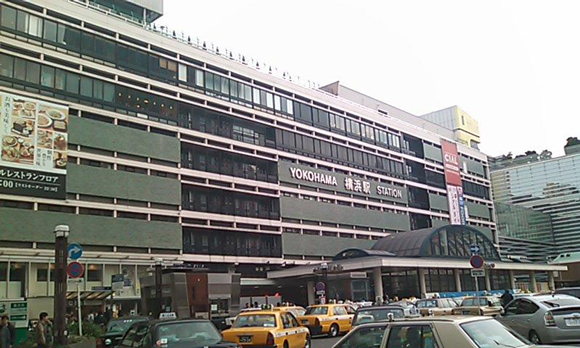
Located in Yokohama city near the border of Kanagawa Prefecture and Tokyo, this was one one of Japan’s first great stations. A few moves and destruction caused by the Great Kanto Earthquake left it in its current location now.
The station is the nucleus to a vertically and horizontally sprawling commercial area hosting most if not all of Japan’s major chain stores like Takashimaya and Yodobashi Camera.
#4 Umeda Station (Osaka, Japan) – Approx. 820,000,000
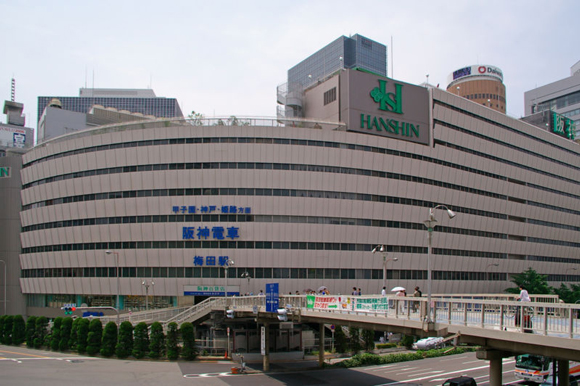
As a resident of Osaka, this station is my own slice of nightmare. Every time I go there it tends to end with me huddled in a corner crying. This multilevel serpentine station hosts ever running rivers of people bumping into one another walking in every direction at the same time.
Remember one of those typical video game levels where you constantly walk through one door only to find yourself in the same room until you throw your controller at your little brother? It’s kind of like that.
But we’ve only just begun.
#3 Ikebukuro Station (Tokyo, Japan) – Approx. 910,000,000
Located in the heart of Tokyo, it’s no wonder Ikebukuro station is so heavily used. As a result it’s home to a bevy of attractions like gourmet hotdogs, penguins on waterslides, alleged teenage girl viewing clubs, and the occasional Cornman sighting.
Ikebukuro Station feeds lines into Shinjuku Station along with…
#2 Shibuya Station (Tokyo, Japan) – Approx. 1,090,000,000
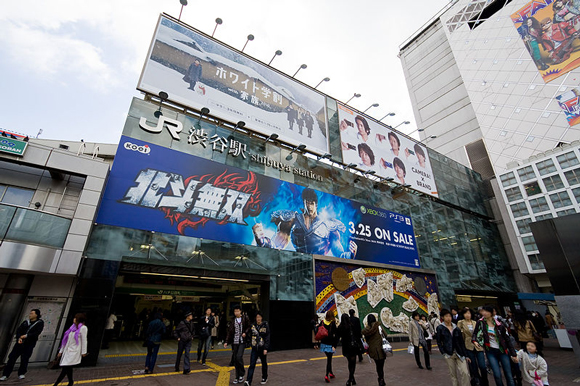
Also in the center of Tokyo, Shibuya station has a kind of nice atmosphere to it that can almost distract an agoraphobe from the hordes of commuters passing through. The station also features large, eye-catching artwork from Taro Okamoto.
There’s also a statue to Hachiko near one of the exits. Hachiko was the dog immortalized in Japanese and (to a lesser extent) American movies as the dog who faithfully waited for his dead master outside of Shibuya station for nine years.
Shibuya and Ikebukuro Stations stand on either side of Shinjuku Station. You can probably see where this is going.
#1 Shinjuku Station (Tokyo, Japan) – Approx. 1,260,000,000
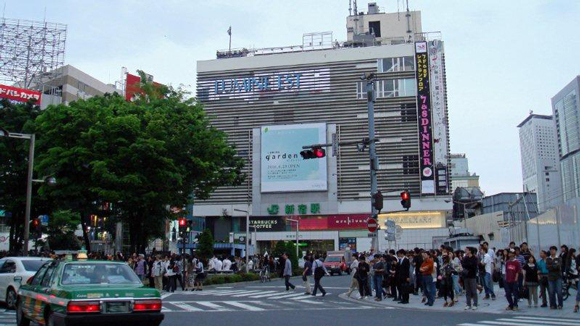
Many people are often in awe of Shinjuku Station’s massive size or complain about its complexity, built to handle over one million daily commuters. I don’t know what their problem is. Here’s a perfectly simple map of the place:
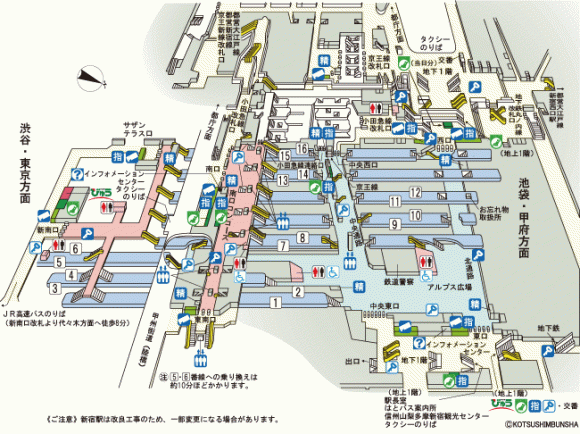
Actually this is just the JR-East railway section of the station which accommodates four other train operators. So multiply that map by about three and you’ll have the rough make-up of the basic station. Throw in all the other shopping and entertainment facilities often found around train stations and you have a labyrinth that’d make David Bowie give a whistling admiration.
The above graph leaves little in the way of concrete details such as the date of the information, so it’s hard to gauge how accurate the data is, but checking a few of the station’s statistics it seems to check out.
For example, India’s Chhatrapati Shivaji Terminus reportedly handles 3,000,000 people a day but it’s uncertain.
Also, if the rapid development of China continues unabated we may soon see more of their stations popping up in the rankings. So, you may want to take these figures with a grain of salt.
Here’s the full list of 51 stations. If you don’t live in Japan there’s a slight chance your country is on there.
1 Shinjuku (Tokyo, Japan)
2 Shibuya (Tokyo, Japan)
3 Ikebukuro (Tokyo, Japan)
4 Umeda (Osaka, Japan)
5 Yokohama (Kanagawa, Japan)
6 Kita-Senju (Tokyo, Japan)
7 Nagoya (Aichi, Japan)
8 Tokyo (Tokyo, Japan)
9 Shinagawa (Tokyo, Japan)
10 Takadanobaba (Tokyo, Japan)
11 Namba (Osaka, Japan)
12 Shinbashi (Tokyo, Japan)
13 Tennouji (Osaka, Japan)
14 Akihabara (Tokyo, Japan)
15 Kyoto (Kyoto, Japan)
16 Sannomiya (Kobe, Japan)
17 Omiya (Saitama, Japan)
18 Yurakucho-Hibiya (Tokyo, Japan)
19 Nishi-Funabashi (Chiba, Japan)
20 Meguro (Tokyo, Japan)
21 Daimon-Hamamatsucho (Tokyo, Japan)
22 Ueno (Tokyo, Japan)
23 Oshiage (Tokyo, Japan)
24 Paris Nord (Paris, France)
25 Taipei Railway Station (Taipei,Taiwan)
26 Machida (Tokyo, Japan)
27 Gare de Chatelet (Paris, France)
28 Kawasaki (Kanagawa, Japan)
29 Roma Termini Railway Station (Rome, Italy)
30 Tamachi-Mita (Tokyo, Japan)
31 Kyobashi (Osaka, Japan)
32 Funabashi (Chiba, Japan)
33 Ayase (Tokyo, Japan)
34 Hamburg Central Station (Hamburg, Germany)
35 Yoyogi-Uehara (Tokyo, Japan)
36 Kamata (Kamata, Japan)
37 Gotanda (Tokyo, Japan)
38 Kichijoji (Tokyo, Japan)
39 Kaneyama (Aichi, Japan)
40 Musashikosugi (Kanagawa, Japan)
41 Fujisawa (Kanagawa, Japan)
42 Oimachi (Tokyo, Japan)
43 Nakano (Tokyo, Japan)
44 Tachikawa (Tokyo, Japan)
45 Iidabashi (Tokyo, Japan)
46 Kashiwa (Chiba, Japan)
47 Hakata (Fukuoka, Japan)
48 Tsuruhashi (Osaka, Japan)
49 Nishi-Nippori (Tokyo, Japan)
50 Nakameguro (Tokyo, Japan)
51 Zurich Main Station (Zurich, Switzerland)
More Countries Join the New List of 100 Busiest Train Stations, Japan Still Claims 82 of Them
Source: Himasoku (Japanese)

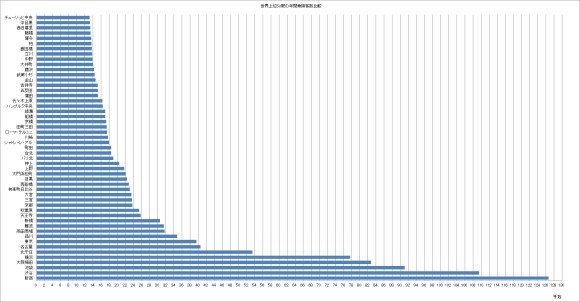
 Kansai and Kanto prove again that they are each distinct regions when it comes to food
Kansai and Kanto prove again that they are each distinct regions when it comes to food Welcome the New Year with a calendar of hunky Japanese farmers 【Pics】
Welcome the New Year with a calendar of hunky Japanese farmers 【Pics】 Tokyo trains to ease cellphone restrictions near priority seats — but not during rush hour
Tokyo trains to ease cellphone restrictions near priority seats — but not during rush hour Japan Snow Battle Federation looking to make snowball fights Olympic event
Japan Snow Battle Federation looking to make snowball fights Olympic event Foreign tourists pick the top 10 must-visit museums in Japan
Foreign tourists pick the top 10 must-visit museums in Japan Foreigner’s request for help in Tokyo makes us sad for the state of society
Foreigner’s request for help in Tokyo makes us sad for the state of society Seaside scenery, history, and so many desserts on Yokohama’s Akai Kutsu【Japan Loop Buses】
Seaside scenery, history, and so many desserts on Yokohama’s Akai Kutsu【Japan Loop Buses】 Mikado Coffee is a 76-year-old coffee chain with a major celebrity connection
Mikado Coffee is a 76-year-old coffee chain with a major celebrity connection Do Hi-Chew-flavor Hi-Chews have a reason to exist?【Taste test】
Do Hi-Chew-flavor Hi-Chews have a reason to exist?【Taste test】 Akihabara pop-up shop sells goods made by Japanese prison inmates
Akihabara pop-up shop sells goods made by Japanese prison inmates What it’s like to spend the night in a Pokémon hotel room
What it’s like to spend the night in a Pokémon hotel room Sakura tree falls on man at Sannenzaka near Kiyomizu temple in Kyoto 【Breaking News】
Sakura tree falls on man at Sannenzaka near Kiyomizu temple in Kyoto 【Breaking News】 Does the virgin-killing sweater really kill virgins?【Video】
Does the virgin-killing sweater really kill virgins?【Video】 Shohei Ohtani’s personal interpreter fired, accused of “massive theft” to pay off gambling debts
Shohei Ohtani’s personal interpreter fired, accused of “massive theft” to pay off gambling debts Spirited Away train station and submerged tracks attract Ghibli fans around Japan
Spirited Away train station and submerged tracks attract Ghibli fans around Japan McDonald’s new Happy Meals offer up cute and practical Sanrio lifestyle goods
McDonald’s new Happy Meals offer up cute and practical Sanrio lifestyle goods Japanese ramen restaurants under pressure from new yen banknotes
Japanese ramen restaurants under pressure from new yen banknotes French Fries Bread in Tokyo’s Shibuya becomes a hit on social media
French Fries Bread in Tokyo’s Shibuya becomes a hit on social media Studio Ghibli releases new action figures featuring Nausicaä of the Valley of the Wind characters
Studio Ghibli releases new action figures featuring Nausicaä of the Valley of the Wind characters Red light district sushi restaurant in Tokyo shows us just how wrong we were about it
Red light district sushi restaurant in Tokyo shows us just how wrong we were about it New private rooms on Tokaido Shinkansen change the way we travel from Tokyo to Kyoto
New private rooms on Tokaido Shinkansen change the way we travel from Tokyo to Kyoto Tokyo Tsukiji fish market site to be redeveloped with 50,000-seat stadium, hotel, shopping center
Tokyo Tsukiji fish market site to be redeveloped with 50,000-seat stadium, hotel, shopping center Beautiful Ghibli sealing wax kits let you create accessories and elegant letter decorations【Pics】
Beautiful Ghibli sealing wax kits let you create accessories and elegant letter decorations【Pics】 Japanese city loses residents’ personal data, which was on paper being transported on a windy day
Japanese city loses residents’ personal data, which was on paper being transported on a windy day Studio Ghibli releases Kiki’s Delivery Service chocolate cake pouches in Japan
Studio Ghibli releases Kiki’s Delivery Service chocolate cake pouches in Japan New definition of “Japanese whiskey” goes into effect to prevent fakes from fooling overseas buyers
New definition of “Japanese whiskey” goes into effect to prevent fakes from fooling overseas buyers Our Japanese reporter visits Costco in the U.S., finds super American and very Japanese things
Our Japanese reporter visits Costco in the U.S., finds super American and very Japanese things All-you-can-drink Starbucks and amazing views part of Tokyo’s new 170 meter-high sky lounge
All-you-can-drink Starbucks and amazing views part of Tokyo’s new 170 meter-high sky lounge More foreign tourists than ever before in history visited Japan last month
More foreign tourists than ever before in history visited Japan last month New Pokémon cakes let you eat your way through Pikachu and all the Eevee evolutions
New Pokémon cakes let you eat your way through Pikachu and all the Eevee evolutions Disney princesses get official manga makeovers for Manga Princess Cafe opening in Tokyo
Disney princesses get official manga makeovers for Manga Princess Cafe opening in Tokyo Sales of Japan’s most convenient train ticket/shopping payment cards suspended indefinitely
Sales of Japan’s most convenient train ticket/shopping payment cards suspended indefinitely Sold-out Studio Ghibli desktop humidifiers are back so Totoro can help you through the dry season
Sold-out Studio Ghibli desktop humidifiers are back so Totoro can help you through the dry season Japanese government to make first change to romanization spelling rules since the 1950s
Japanese government to make first change to romanization spelling rules since the 1950s Ghibli founders Toshio Suzuki and Hayao Miyazaki contribute to Japanese whisky Totoro label design
Ghibli founders Toshio Suzuki and Hayao Miyazaki contribute to Japanese whisky Totoro label design Doraemon found buried at sea as scene from 1993 anime becomes real life【Photos】
Doraemon found buried at sea as scene from 1993 anime becomes real life【Photos】 Tokyo’s most famous Starbucks is closed
Tokyo’s most famous Starbucks is closed One Piece characters’ nationalities revealed, but fans have mixed opinions
One Piece characters’ nationalities revealed, but fans have mixed opinions We asked a Uniqlo employee what four things we should buy and their suggestions didn’t disappoint
We asked a Uniqlo employee what four things we should buy and their suggestions didn’t disappoint Princesses, fruits, and blacksmiths: Study reveals the 30 most unusual family names in Japan
Princesses, fruits, and blacksmiths: Study reveals the 30 most unusual family names in Japan Sturgeons in Japanese village outnumber human population, used as marketing strategy
Sturgeons in Japanese village outnumber human population, used as marketing strategy Only one out of five Japanese people can pronounce these hiragana — can you?
Only one out of five Japanese people can pronounce these hiragana — can you? Old-school train car and tourist information center in Shibuya set to move to Akita this summer
Old-school train car and tourist information center in Shibuya set to move to Akita this summer Massive manga mural takes over Tokyo station to celebrate Jujutsu Kaisen【Photos】
Massive manga mural takes over Tokyo station to celebrate Jujutsu Kaisen【Photos】 New indie game The Exit 8 may make us never want to enter another Japanese subway station again
New indie game The Exit 8 may make us never want to enter another Japanese subway station again Moving to Tokyo? Here are the three best, most reasonable neighborhoods to live in
Moving to Tokyo? Here are the three best, most reasonable neighborhoods to live in Japan Railways looking for love in all the weird places again with the Love Love Bench
Japan Railways looking for love in all the weird places again with the Love Love Bench Crazy photo shows how Tokyo’s Shinjuku Station can be as confusing as a video game dungeon
Crazy photo shows how Tokyo’s Shinjuku Station can be as confusing as a video game dungeon Want to choose the name of Tokyo’s most important new station? Here’s your chance!
Want to choose the name of Tokyo’s most important new station? Here’s your chance! Japan’s “station closest to the sea” lives up to its name【Photos】
Japan’s “station closest to the sea” lives up to its name【Photos】 The 10 best places for young, single people to live in and around Tokyo【Survey】
The 10 best places for young, single people to live in and around Tokyo【Survey】 Virtual YouTubers in our world? Giant signs at Tokyo stations show Hololive talent and human fans
Virtual YouTubers in our world? Giant signs at Tokyo stations show Hololive talent and human fans 11 cheapest Tokyo neighborhoods to rent an apartment in show living here’s not an impossible dream
11 cheapest Tokyo neighborhoods to rent an apartment in show living here’s not an impossible dream Strange bird outside Shinjuku Station looks like a reincarnated salaryman
Strange bird outside Shinjuku Station looks like a reincarnated salaryman JR East to release official train simulator on Steam on 20 September
JR East to release official train simulator on Steam on 20 September Smartphone app finds empty restroom stalls in Tokyo subway station, makes pooing easier than ever
Smartphone app finds empty restroom stalls in Tokyo subway station, makes pooing easier than ever
Leave a Reply